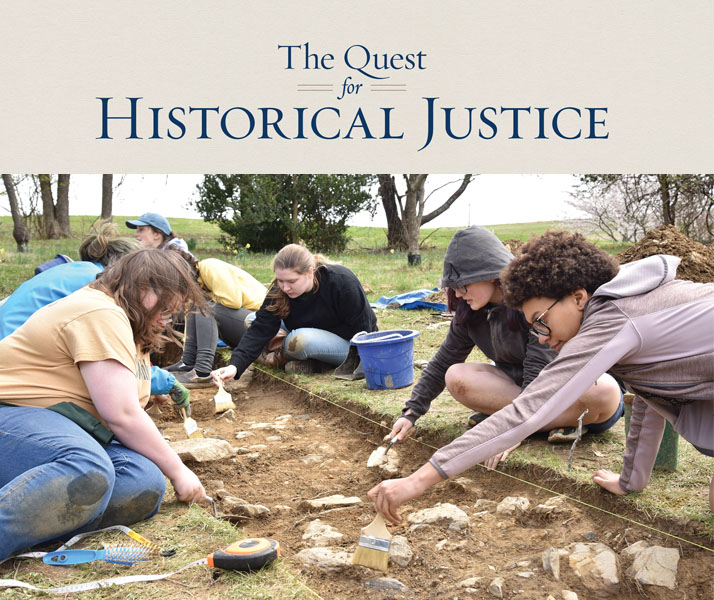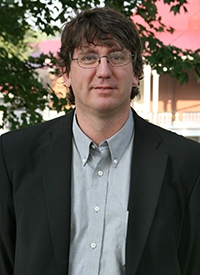
The Quest for Historical Justice
Hosting the Universities Studying Slavery conference last spring symbolizes Hollins’ efforts to come to terms with its own connection with enslavement.
By Jeff Hodges M.A.L.S. ’11

Some of the more than 20 students who spent a week digging in the first on-campus archeological site, located near the library. Photo by Sharon Meador
In 2016, a group of students, faculty, and staff coalesced with a goal of promoting campus-wide dialogue on issues of collective memory, diversity, and reconciliation. Nearly two years after it began, the Hollins Heritage Committee (HHC) achieved a major milestone when it brought the spring meeting of Universities Studying Slavery (USS) to the school in April. One of nearly 40 USS member colleges and universities from around the country that are exploring the historical role of slavery at their respective institutions, Hollins hosted the semi-annual meeting to discuss strategies, collaborate on research, and learn from one another.

Bohland
“I think all of us involved in making this conference possible knew it was the right decision for our campus to host this event, as it has been our goal from the beginning to be at the forefront of the Universities Studying Slavery movement,” said Jon Bohland, associate professor of international studies and HHC chair.
USS organizes multi-institutional cooperation as part of an effort to facilitate mutual support in the pursuit of common goals. It also enables participating institutions to work together as they address both historical and contemporary issues dealing with race and inequality in higher education and in campus communities, as well as the complicated legacies of slavery in modern American society.
Among the highlights of the USS spring meeting at Hollins were sessions devoted to strengthening historically black colleges and universities; collective wisdom workshops for small colleges, liberal arts universities, and research universities; and discussions among traditionally Baptist colleges and universities that focused on developing common research agendas and collaborative practices.
During the conference, Bohland paid tribute to the student activists at Hollins who were the catalysts for HHC’s creation and have subsequently undertaken a number of projects to further its mission. “It was students who demanded that our university openly acknowledge our past connections to enslavement and begin to find ways to reconcile that history. As a result of [their] direct action, hard questions are being asked, long-lost names are being found, classes are being taught, conferences are being held, and we can begin to honor these previously unacknowledged founders and supporters of the university.”
President Pareena Lawrence stated at the spring meeting’s opening session, “If we are to grow and evolve as institutions of higher learning, we cannot ignore or hide from our past. Indeed, at the very least we owe the enslaved who built and labored for our colleges and universities the fundamental decency of recognition and gratefulness. And in their memories, we must use that knowledge and understanding to promote diversity and inclusivity.
“We cannot even come close to repaying our debt or making amends,” she continued, “but through our discussions and research, we can take vital steps to ensure we undertake what social scientists call ‘historical justice.’”

Glenn
Idella Glenn, Hollins’ special advisor on inclusivity and diversity, told the conference audience that the institution had begun to “dig into our past…to uncover the untold history of Hollins University.” One such literal endeavor occurred a couple of weeks before the USS spring meeting with the establishment of the first on-campus archeological site, led by the HHC and supported by a team from Wake Forest University. More than 20 students spent a week digging in an area near the Wyndham Robertson Library that is believed to have been the location of a home called Edgehill in the 19th century.
“We know the campus as it is now, but there were so many people who contributed to making this university,” international studies major Cheyenne Wright ’18 told The Roanoke Times. “It’s interesting to see what we can find out, to learn how they lived and where they lived.” The Times reported, “Students have uncovered ceramic fragments, building materials, coal, and other remnants of a bygone era.”
Glenn expressed that some of the results of research into the history of the enslaved at Hollins “are not easy to look at and may even cause pain and discomfort. But we must deal with it if we are to heal and move forward. I especially applaud the courage of our students, faculty, and staff who have earnestly taken on this difficult work. We have a responsibility in society, especially in higher education, to fully examine our history and put energies toward addressing the impact of the ‘peculiar institution’ of slavery.”
Glenn stated that the investigations and conversations at Hollins are helping to inform the breadth and scope of memorialization, which includes interactive education on campus and community outreach in the Roanoke Valley. “I have come to the knowledge that this work of digging into our past and reconciling our history is foundational to authentic diversity, equity, and inclusion work,” she said.
Jeff Hodges is Hollins’ director of public relations.
